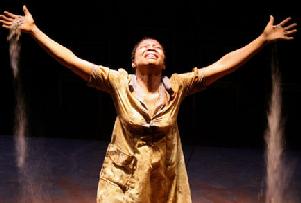
Yael Farber
Στην «Ορέστεια» του Αισχύλου βασίστηκε η Νοτιοαφρικανή συγγραφέας και σκηνοθέτις Yael Farber για να γράψει το ιδιαίτερα επιτυχημένο στο εξωτερικό θεατρικό έργο «Μολόρα». Ενα έργο που θα παρουσιαστεί στο πλαίσιο του φεστιβάλ «Θέατρο Πέρα από τα Ορια», στις 28, 29 και 30 Μαΐου, στο θέατρο «Δημήτρης Χορν». Στην εκδοχή της Farber η δράση τοποθετείται στη μετα-απαρτχάιντ Νότια Αφρική. «Μολόρα», στα σεσότο, διάλεκτο νοτιοαφρικανική, σημαίνει «τέφρα», κι εδώ, η στάχτη του καμένου κορμιού του Ορέστη είναι για την Ηλέκτρα το θλιβερό λείψανο μιας έρημης χώρας, ενώ το ρόλο του Χορού αναλαμβάνει χορωδία γυναικών της φυλής Xhosa. Επιπλέον, στη μεταφορά της, η Farber χρησιμοποιεί μια λευκή ηθοποιό ως Κλυταιμνήστρα, ενώ η Ηλέκτρα και ο Ορέστης είναι μαύροι. Με αυτό τον τρόπο μοιάζουν σαν υπηρέτες μέσα στο ίδιο τους το σπίτι. Οπως οι Ευρωπαίοι πήγαν στην πατρίδα των Αφρικανών και τους μετέτρεψαν σε υπηρέτες.
Μια ώριμη, μαύρη γυναίκα με δυσκολία σέρνει το βήμα της στη σκηνή, όπου υπάρχουν δύο καρέκλες και δύο γραφεία - η αυστηρή αίθουσα της Επιτροπής για την Αλήθεια και τη Συμφιλίωση, στη Νότια Αφρική. Με αργές κινήσεις τραβά ένα κομμάτι μουσαμά και αποκαλύπτει έναν αμμώδη τάφο, που παραπέμπει στο βίαιο παρελθόν της ηπείρου. Η λευκή νοτιοαφρικανή σκηνοθέτρια Γιαέλ Φάρμπερ με την παράσταση «Μολόρα» που ανεβαίνει στο Θέατρο «Δημήτρης Χορν» (Αμερικής 10, από την Τετάρτη ώς την Παρασκευή, έπειτα από πρόσκληση της Αττικής Πολιτιστικής Εταιρείας) επιχειρεί ένα τολμηρό όσο και ενδιαφέρον εγχείρημα, διασκευάζοντας και μεταφέροντας τον αιματηρό κύκλο της «Ορέστειας» του Αισχύλου στη μετα-απαρτχάιντ εποχή. «Από παλαιότερα είχα έρθει σε επαφή με το έργο του Αισχύλου και του Σοφοκλή», μας λέει από το τηλέφωνο η βραβευμένη σκηνοθέτρια που βρίσκεται στη δημιουργική περίοδο των τριάντα και κάτι. «Η "Ορέστεια" έχει επιζήσει γιατί μιλάει κατευθείαν στην καρδιά. Είναι ένα κείμενο επικό, συγκλονιστικό και ταυτόχρονο πολύ ανθρώπινο. Ηθελα μέσα από μια αρχαία τραγωδία να μιλήσω για μια σύγχρονη τραγωδία»... [Της ΠΑΡΗΣ ΣΠΙΝΟΥ, Κυριακάτικη Ελευθεροτυπία, 25/5/2008]
Dorothy Ann Gould (by Ruphin Coudyzer)

In
Molora , the South African director Yael Farber who was responsible for 2004's hit
Amajuba, turns to Greek Tragedy. Based on Aeschylus'
Oresteia but also incorporating elements from Sophocles'
Electra, this version relocates the ancient myth to contemporary South Africa, exploring its themes of revenge and forgiveness with special relevance to the establishment of democracy in the 1990s and the appeasement of avenging anger after the abuses of a white minority.
Mainly following the action of the trilogy's middle play, the
Choephoroe, Agamemnon's murder at the hands of his unfaithful wife (Dorothy Ann Gould) is recounted as a past event. Their grieving daughter Elektra (Jabulile Tshabalala) is now trapped at home under Klytemnestra's indomitable tyranny but determined to exact vengeance on her murderous mother. Her brother Orestes (Sandile Matsheni), who was smuggled away as an infant, is now grown up and fully capable of executing this revenge. Instead of long Aeschylean monologues or choral odes, the narrative and back-story are portrayed via interwoven sequences and live graphic brilliance. For example, Klytemnestra's dream that she gives birth to a snake who suckles blood from her breast, fuelled both by guilt and prophecy prior to Orestes' return, is gruesomely acted out onstage. A sand pile representing Agamemnon's tomb is central to the stage throughout, around which the action revolves both physically and figuratively. In this way, the audience share a strong sense of this primeval tragedy's viscerality.

Jabulile Tshabalala as Elektra
(Photo: Christian Enger) Adding to the production's earthy, primitive feel are the chorus of rural Xhosa tribeswomen who provide traditional "split tone" singing with incredible vocal strains and texture. Permanently onstage, their role as a truth and reconciliation commission is hinted at and they become the perfect observers and jury of the action.
Key to this reimagining of the myth, the chorus represent the end of the curse on the house of Atreus. They intervene in the action (contrary to the convention of Attic tragedy) to prevent the matricide and they represent humanity's capacity for forgiveness by forming the committee which explores and absolves past crimes. Aeschylus' gods are thus replaced by this paradigm for humanity. In the
Oresteia , the human solution (democratic legal justice) results in an impasse when the jury's votes are equally split and the goddess Athena only ends the curse by appeasing the Erinyes with promise of civic inclusion.
Molora, on the other hand, presents a more hopeful and generally humanistic resolution: the end to the self-perpetuating cycle of revenge lies in men's own ability to achieve reconciliation via forgiveness. This version conclusively answers questions which Aeschylus provocatively left unresolved. Nevertheless, it cannot be accused of self-complacency in view of its truthful inspiration: the successful establishment of peaceful democracy in South Africa.
My main caveat regarding this production is that the audience ideally need to know the original trilogy in some depth before fully appreciating this play. Uncomfortable in many places (including sequences of onstage tortures) and unafraid of using silences and pauses in action, this is a vivid, untamed production which is ultimately a paean to humanity in the midst of self-destructive violence.



No comments:
Post a Comment